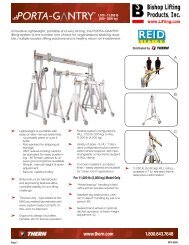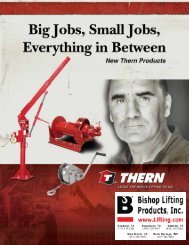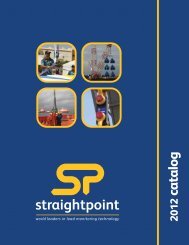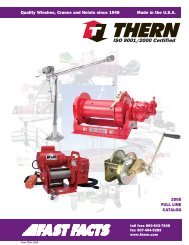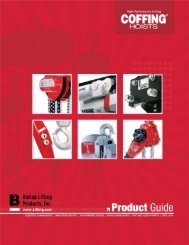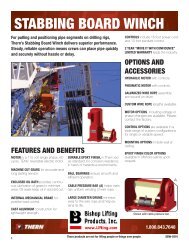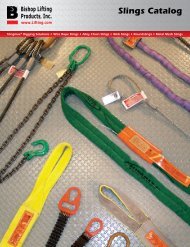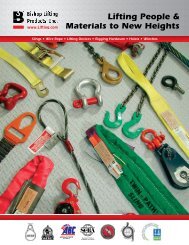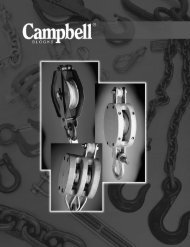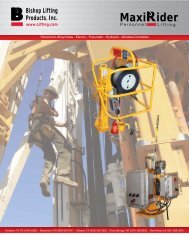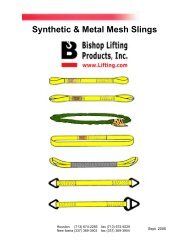warning - Bishop Lifting Products, Inc.
warning - Bishop Lifting Products, Inc.
warning - Bishop Lifting Products, Inc.
You also want an ePaper? Increase the reach of your titles
YUMPU automatically turns print PDFs into web optimized ePapers that Google loves.
Metal Mesh Slings<br />
Identification, Inspection,<br />
and Rigging Practices<br />
Metal Mesh Slings<br />
Identification, Inspection, and Rigging Practices<br />
Metal Mesh Slings are designed and built for rugged lasting service. As with any quality product certain precautions and standards of<br />
treatment should be observed. Proper care will extend the useful life of the metal mesh sling.<br />
Follow the Guidelines set forth in ASME B30.9 “Slings” standard, OSHA 1910.184 and 1926.251.<br />
Sling Identification<br />
• Each Metal mesh sling shall be marked to show the following<br />
• Name or Trademark of manufacturer<br />
• Rated loads for the type(s) of hitch(es) used and the angle upon with it is based<br />
• Width and gauge<br />
• Number of legs, if more than one<br />
• Individual sling identification (e.g., serial numbers)<br />
Sling identification shall be done by the sling manufacturer, and should be maintained by the user so as to be legible during the life<br />
of the sling.<br />
Inspection<br />
Metal Mesh Sling inspection falls into 3 categories. Initial, Frequent, and Periodic.<br />
• Initial Inspection– Prior to use, all new, altered, modified, or repaired slings shall be inspected by a designated person to verify<br />
compliance with the applicable provisions of this chapter<br />
• Frequent Inspection<br />
o A visual inspection for damage shall be performed by the user of other designated person each day or shift the sling is used<br />
o Conditions such as those listed in the removal criteria section or any other condition that may result in a hazard shall not<br />
be returned to service until approved by a qualified person<br />
o Written records are not required for frequent inspections<br />
• Periodic Inspections<br />
o A complete inspection for damage to the sling shall be periodically performed by a designated person. Inspection shall be<br />
conducted on the entire length including splices, end attachments, and fittings. The sling shall be examined for conditions<br />
such as those listed in the removal criteria section and a determination made as to whether they constitute a hazard<br />
o Periodic Inspection Frequency – Periodic inspection intervals shall not exceed 1 year. The frequency of periodic inspections<br />
should be based on:<br />
o<br />
• Frequency of sling use<br />
• Severity of service condition<br />
• Nature of lifts being made<br />
• Experience gained on the service life of slings used in similar circumstances<br />
Guidelines for time intervals<br />
• Normal service – yearly<br />
Severe service – monthly to quarterly<br />
•<br />
• Special service – as recommended by a qualified person<br />
o A written record of the most recent periodic inspection shall be maintained<br />
Removal Criteria<br />
A wire rope sling shall be removed from service if the following conditions are present.<br />
o Missing or illegible sling identification (tag or markings)<br />
o Broken weld or broken brazed joint along the sling edge<br />
o Broken wire in any part of the mesh<br />
o Reduction in the wire diameter of 25% due to abrasion or 15% due to corrosion<br />
o Lack of flexibility due to distortion of the mesh<br />
o Distortion of the choker fitting so the depth of the slot is increased by more than 10%<br />
o Distortion of either end fitting so the width of the eye opening is decreased by more than 10%<br />
o A 15% reduction of the original cross-sectional area of any point around the hook opening of the end fitting<br />
o Visible distortion of either end fitting out of its plane<br />
o Cracked end fitting<br />
o Slings in which the spirals are locked or without free articulation shall not be used<br />
o Fittings that are pitted, corroded, cracked, bent, twisted, gouged or broken<br />
o Other conditions, including visible damage that can cause doubt as to the continued use of the sling<br />
METAL MESH<br />
SLINGS<br />
Rigging Practices<br />
• Slings shall be shortened or adjusted only by methods approved by the sling manufacturer or a qualified person<br />
• The load shall be evenly distributed across the width of the metal mesh<br />
• The sling shall be hitched in a manner providing control of load<br />
• Slings in contact with edges, corners, or protrusions should be protected with a material of sufficient strength, thickness, and<br />
construction to prevent damage<br />
Metal Mesh Slings 134<br />
(800) 972-1041



